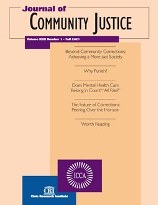Circles of Support and Accountability: Dimensions of Practice, Research, and Interagency Collaboration in Prisoner Reentry
Author: Andrew J. McWhinnie, M.A..; Robin J. Wilson, Ph.D, ABPP.; Robert E. Brown, B.A..
Source: Volume 22, Number 02, Winter 2013 , pp.5-15(11)

< previous article |next article > |return to table of contents
Abstract:
The idea of placing volunteers around sexual offenders as they leave prison was introduced in 1994 as an ad hoc response to the release of a high-risk, repeat sexual offender who had served every single day of his fourth sentence behind bars for sexual offenses against children. Referred to as a “core member,” this individual had no one in the community to turn to, apart from police officers, who technically are off duty at 5:00 PM, for help in solving problems such as where to find food, shelter, clothing, basic safety, or anyone he could call a friend or confidante. A local pastor of an urban Mennonite church, Rev. Harry Nigh, had heard of “Charlie”in passing—several members of his congregation were also members of a prison visitation program and were aware that Charlie was being released. They were worried—for Charlie’s welfare, the welfare of potential child victims, and for their community. With guidance and some facts about sexual offenders provided by correctional psychologist Dr. Robin Wilson, local pastor Rev. Harry Nigh, prison psychologist Bill Palmer, and community chaplain Rev. Hugh Kirkegaard, this small band of volunteers decided to form a “circle” around Charlie as he was released. This first circle was going to try to mediate the community response to Charlie’s release, provide advocacy for him, and help him find resources to meet his very basic human needs. Today, Charlie’s story is often told as the origin of “Circles of Support and Accountability” or CoSA. In this landmark article, current practitioners (and one of the originators) of CoSA comprehensively examine its history, principles, practices, uses, and evidence base.Keywords: CoSA; “Worst of the worst”; high-risk sex offenders; capacity building
Affiliations:
1: Correctional Service of Canada; 2: Wilson Psychological Services LLC; 3: REB Independent Criminal Justice Consulting.